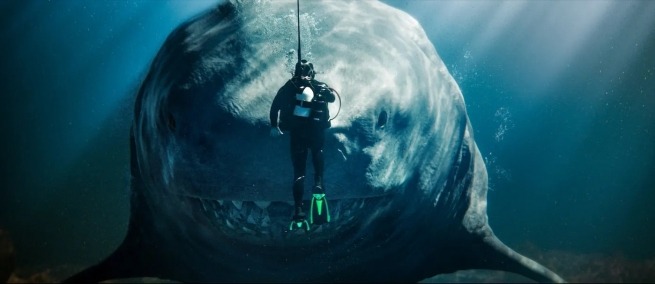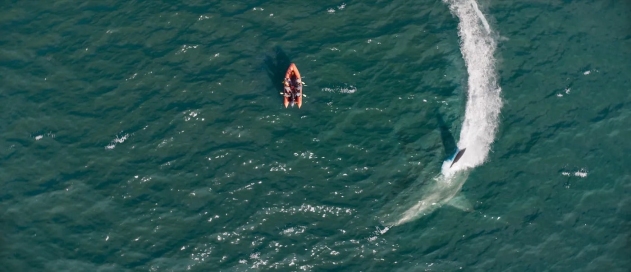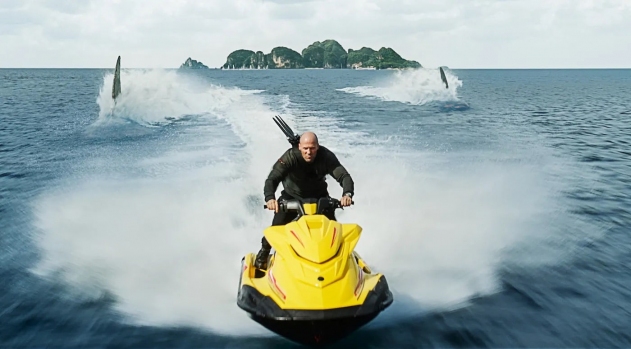
The sequel to the most successful giant shark film since JAWS arrives with MEG 2: THE TRENCH. As a marine biologist who specializes in sharks, and as someone who loves films, I was very excited. Yes, I love giant shark horror films, so I don’t watch them expecting a documentary, but let's address the megalodon-sized elephant in the room; the megalodon is extinct. I have personally seen fervor grow amongst the public who are convinced that the megalodon could still exist in the deep ocean where we cannot observe them. (This all started from a fake megalodon documentary, MEGALODON: THE MONSTER SHARK LIVES, which was on Discovery Channel a few years ago.) While disappointing to many, marine biologists know conclusively that the megalodon is extinct. We have evidence that megalodons, like their distant relatives the white and mako sharks, were warm bodied, meaning their bodies were warmer than the surrounding water. This meant that, like mammals, megs could digest their food more quickly, but at a cost; high metabolic rates. Simply put, megalodons would have had to eat a lot to meet their metabolic needs and they would never have been able to find enough food living in the very deep ocean. In fact, not a single warm-bodied animal nor shark (including cold-bodied species), ever dives to the depths of the Mariana trench—the deepest point of the ocean—where the two MEG films are set. So, there is no possibility of megalodons hiding in the depths where we have simply missed them.

Still from MEG 2: THE TRENCH. Courtesy of Warner Brothers.
In the director’s chair this time around is, somewhat surprisingly, Ben Wheatley, known for low-key but well-regarded folk horror (KILL LIST, FIELD IN ENGLAND) and action films (FREE FIRE). Returning is the legendary Jason Statham as Jonas Taylor and Cliff Curtis as his friend, Mac. MEG 2 starts off with an impressive scene highlighting the food chain many millions of years ago, culminating with a T Rex falling prey to a megalodon. T Rex and megalodon didn’t really overlap in evolutionary time, but it's still a nice way to set up one of the ocean’s greatest predators. However, unlike the original film, MEG 2 is actually less focused on the meg and more focused on the criminals trying to plunder the trench resources.
Several years have passed since the first film and Jonas and colleagues routinely explore the Mariana trench. Their team has decided to keep a surviving meg from the first film in captivity, which they claim to have trained (more on this later). A routine exploration of the trench goes horribly wrong when it’s revealed that a rival organization has been mining precious minerals from the deep ocean and are more than willing to kill to keep their secret operation running. Due to their actions, the captive meg escapes, along with more megs and a giant octopus that wreak havoc at an island resort.
As with the first film, MEG 2 is a lot of fun, especially buoyed by the charms of Statham and Cliff Curtis. Also working well is the new addition of Wu Jing as the brother of Suyin, a character from the first film who has died of unknown reasons. The first film wore the absurdity of its premise on its sleeve, which added to its charm, whereas this comes across less clearly in the sequel. It is no surprise there is little scientific accuracy in the film, beyond the fact that megalodon is alive and well. Perhaps most bizarrely, the deep trench is now inhabited by a species of what was once an air-breathing reptile. The species doesn’t seem to have changed since existing on land during the time of the dinosaurs, and now lives full-time, 11km deep in the ocean. How an air-breathing species has not only remained unchanged but now lives permanently in the deepest part of the ocean is never even given an attempted explanation (Probably for the best). Then there are minor quibbles, like how humans can dive 11km deep in suits for two hours and somehow have enough oxygen? However, some of the scientific aspects I really liked relate to megalodon social behavior. In one great moment, the underwater team witnesses megalodon mating. Shark mating has been observed in several species but not in white sharks or other large species. In general, shark mating consists of multiple males trying to mate with a female and is more similar to mating in mammals than it is to other fish. In MEG 2, we witness two males and a female participate in a mating event, which is certainly a first for a shark horror film. This sets up a further sequel by suggesting our hero (Haiqi, the meg) is pregnant by the end of the film.

Still from MEG 2: THE TRENCH. Courtesy of Warner Brothers.
Another important component of the film is that Jiuming has been training the captive Haiqi, which keeps her from attacking him. There is actually some truth behind this. Obviously, no one has trained a large shark such as a great white, but smaller species have been trained by humans. In fact, juvenile lemon sharks were trained to hit a target and get a food reward and were conditioned quite quickly. Experiments have further shown that sharks can learn by watching other experienced sharks perform a simple task, what animal behaviorists call social learning. Of course, this is a far cry from training a megalodon with a clicker to not eat you, but it added to a general theme in MEG 2 that megalodons are not all bad and actually pretty interesting. As a conservation biologist, I certainly appreciated that angle being included. So, what did I think of the film? When asked to give his opinion at the end of the film on whether the megalodon was actually trained, Jonas (Statham) sums it up nicely: “You’re ridiculous.” Maybe so, but MEG 2 was still a lot of fun to watch.
TOPICS